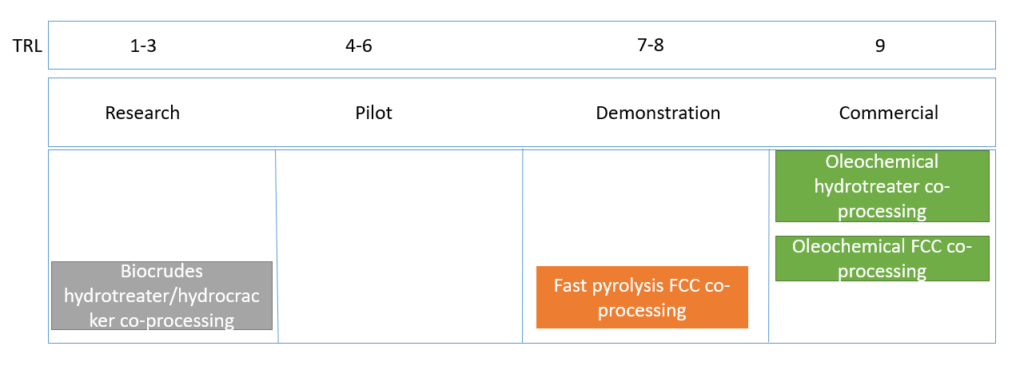Co-processing refers to the simultaneous transformation of biogenic feedstocks and intermediate petroleum distillates such as vacuum gas oil (VGO) in the existing petroleum refinery process units to produce low carbon-intensive fuels. Co-processing is receiving increased attention due to its potential to provide low carbon-intensive fuels, at economically competitive prices, by utilizing existing refining, transport and storage infrastructure. At this time several commercial refiners are exploring both pilot and commercial production of co-processed fuels.
As summarised below ( and shown in Figure below), there are various insertion points that co-processing can be carried out:
- Thermal cracking – In this process, the long-chain hydrocarbons are heated, under pressure, to 450-800°C at which time the hydrocarbon molecules vibrate and are subsequently broken down. However, this process produces products with a high oxygen content, which is not desirable for the production of fuels.
- Catalytic cracking – In this case, the cracking process occurs in the presence of a catalyst that removes oxygen via simultaneous dehydration, decarboxylation and decarbonylation. As no additional hydrogen or energy is required this saves costs and reduces GHG emissions. The usual temperatures for this process are 350-500°C.
- Hydrocracking – This is also a catalytic process carried out at high temperature and high pressure. Although hydrocracking is relatively expensive a good quality product is obtained.
- Hydrotreating – The conversion occurs through decarboxylation, decarbonylation and hydro-deoxygenation and the required temperatures for this process are in the range of 300-350°C. (triglyceride)

The two broad categories of biogenic feedstocks that can be co-processed are:
- lipids/oleochemicals
- biocrude liquid intermediates (produced via fast/ catalytic pyrolysis, hydrothermal liquefaction, etc.)
Both the hydrotreater and the fluid catalytic cracker pathways have been commercialized using oleochemical feedstocks (tallow, canola, soybean oil, etc.). In the mid-to-long term, biocrudes that are made from lignocellulose are expected to be commercialized and they are most likely to be inserted into the fluid catalytic cracker.
Co-processing is a combination of at least four technologies that are at different levels of technology readiness (Figure below). As mentioned earlier, oleochemical feedstocks can be either processed in the hydrotreater or the fluid catalytic cracker. Fast pyrolysis biocrude has been demonstrated at commercial units currently at the fluid catalytic cracker. However, co-processing biocrudes in the hydrotreater remain at the lab/pilot scale.

The potential benefits of co-processing biogenic feedstocks include the ability to leverage existing refinery infrastructure and resources, scalability and flexibility plus ready integration with existing fueling and distribution infrastructure. The main benefit and rationale for co-processing lie in its ability to lower the carbon intensity and the GHG emissions of co-processed fuels. However, the methods used for calculating the carbon intensity of finished or co-processed fuels are still being developed and this will impact how the carbon intensity of the finished fuels is defined.
At this time approximately 40 refineries around the world are co-processing lipid feedstocks at levels ranging from 1-30 vol%. For example, the Preem refinery in Sweden is producing and marketing co-processed low CI fuels. It currently has a 200 ML/yr capacity which will be increased to 1,300 ML/yr by 2023.
IEA Bioenergy task 39 first evaluated the potential of drop-in biofuels in 2014 where co-processing was mentioned. Task 39 further conducted research on co-processing and published two reports in 2019 and 2022. These reports highlighted the opportunities of co-processing which can be relatively easily conducted at existing oil refineries at low cost which will accelerate the production of lower carbon intensity fuels. The reports also noticed the challenges when tracking the green molecules which is essential for refiners to obtain credits under various policies like low carbon fuels standard.
Co-processing at low blends (~5%) can be carried out with minimum investment in infrastructure, as demonstrated by Parkland. Based on previous BC-SMART work, 650 million litres year of co-processed fuels (Figure below) can be obtained at a 30% co-processing ratio at B.C.’s two refineries (combined capacity of refineries: 67000 bbl/d). This could result in a reduction such that the CleanBC renewable fuels targets (2030) could be met.

Supported by:


